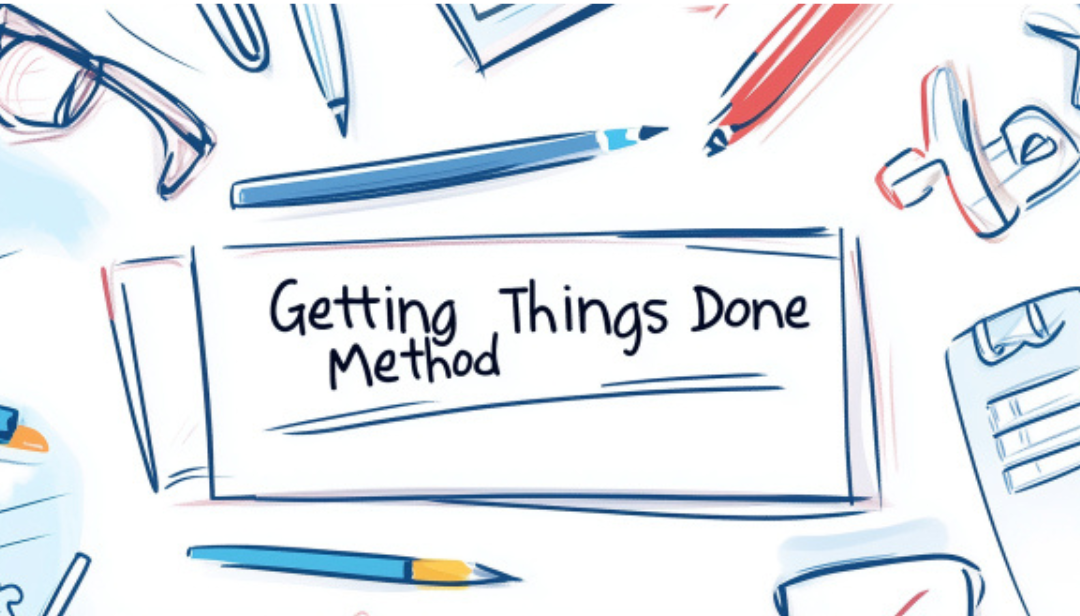Getting Things Done Technique: Time Management Hack to Crash Your To-Do-Lists
Are you constantly overwhelmed with your to-do list to the point where your productivity halts to zero? We live in a world with so much to do and so little time to do it. We have a time management hack that could help – the Getting Things Done (GTD) technique. Give it a shot!


Back
7 mins read
Are you always looking at your to-do list and left wondering what to do and what to leave out? Worse still, does your productivity constantly plummet, and you find yourself putting out little fires at every corner?
It's easy to achieve your daily goals when you're supercharged, and your psyche is in the perfect place.
But those days are few and scattered compared to the not-so-productive days. Often, our to-do lists get cluttered; we lose track of time and dread the next assignment or office meeting. Is it even possible to organize tasks, beat burnout, and get things done stress-free and efficiently? All while consistently keeping productivity at its peak?
The Getting Things Done (GTD) time management methodology can help you do it, allowing you to achieve much more in your career and personal life.
Let's delve deeper into this powerful time management technique.
How’s your time management skills? Take this free test to assess.
What Is the Getting Things Done Method?

David Allen, American productivity consultant and author, is the brains behind the Getting Things Done (GTD) method, published in a book under the same name. It’s a personal-management system that provides a practical approach to achieving your goals in a relaxed and productive state.
The concept here is writing down all your tasks (both in your professional and private life) to make sure you don’t forget them.
As Allen puts it, "Your mind is for having ideas, not holding them''. By listing them down and running the tasks through a trusted schedule system, there is no need to recall them. This way, you're less stressed and can attend to each task more intelligently. Put simply, regularly emptying our brain's short-term memory increases concentration levels.
How Does the Getting Things Done Method Work?
If you asked an individual who presumably has many tasks to get to, what's top of their wish list, they would say more time. And this is one of the biggest mistakes we make. We don't need more time; we need a practical system to control our time utilization.
Control, according to GTD, can be achieved by using efficient tools to list your tasks and keeping a consistent routine to keep track of your progress in the set timelines.
The GTD technique helps you to redefine how you approach time management through a horizontal 5-step process:
GTD Step 1: Capture
How often has a brilliant idea come to mind while you are doing something, and as more tasks take over your day, the idea fizzles away? That's because, as we stated earlier, your brain is for having ideas, not for storing them.
The first step is to relieve your mind from reminding you of anything.
Write and record all the tasks that have your attention currently and arrange them in inboxes. An inbox is a crucial aspect of the GTD technique. It’s a central place that holds everything that sweeps through your mind. These could be work tasks, appointments, and home errands.
An inbox can be analog or digital. You can choose to have a good ol' notebook as an inbox or adopt digital note-taking apps like Microsoft's OneNote or Evernote.
At first, you may have to create several inboxes; but try as much to narrow down to a few places so you can have a quick overview of what's expected in any given timeline.
GTD Step 2: Clarify
Review all the tasks you’ve collected in the inboxes and sort them using the Getting Things Done strategy. Ask yourself these questions:
- What kind of a task is it? Actionable or non-actionable?
- Is it a task I can complete now?
- What’s the next action?
If it’s an actionable task, here’s how you can handle it effectively:
Do It
Follow the 2-minute rule. If it takes less than two minutes to complete, do it immediately. Be careful, however, not to get sucked into an endless cycle of handling mini-tasks.
Delegate it
If you can’t complete the task or someone may be better at it, delegate it.
Defer It
These include tasks requiring more than two minutes and further processing before placing them in the right inbox.
If the task is not actionable, you can proceed with any of the following actions:
Delete It
If you don’t want to devote time or effort to it, delete it.
Defer It
This is a maybe/someday list.
Archive it for future reference
You may not need to act on it, but you would love to keep it.
GTD Step 3: Organize
Once you have clarified your tasks into actionable and non-actionable categories, you can now proceed to organize and prioritize them based on an action plan. The concept here is to break down tasks into subtasks and attach the actions and timelines you need to complete them.
In the previous step of clarification, we pointed out that any task that requires less than two minutes to do should be done immediately. However, you may have a task that takes more than two minutes but requires only one step to complete it. In GTD, this is known as a one-off task, and you can opt to do it at once based on its priority.
However, you’ll realize that most of your tasks are projects.
According to the GTD method, a task that requires more than one action to complete is a project. For better organization, categorize your projects based on areas of focus depending on the responsibilities you have in life. There are two main areas you often focus on — work and personal.
From there, organize these tasks into the following categories or “folders”:
- “One Day” folder — You can place any project that’s not urgent here awaiting further action in the future.
- Pending folder — This one contains all ongoing tasks which are on hold, or you’re awaiting a response to continue with them.
- Reference folder — You can place any tasks that don’t need action but can be used as a reference somewhere in your life here. Consider it as a “bookmark folder.”
- Calendar folder — This folder contains all tasks that have a specific deadline to complete, e.g., events, appointments, and meetings. Schedule them here with the appropriate dates associated with the tasks.
GTD Step 4: Reflect and Review
Reflection involves taking a step back and looking at what you've accomplished and the next steps to take. This review process is a non-negotiable and crucial step in the GTD method.
Reviewing and updating your lists allows you to focus on the current task without worrying that you may be missing another appointment.
You can choose between a daily review as you pick your next task or a 1 to 2-hour weekly review. The goal is to keep your productivity levels up by controlling your time.
GTD Step 5: Engage
With the lists all set, you now have to choose what to do first and when. David Allen offers four criteria to help you decide:
Context
Your life is made up of different contexts, including work, home, and hobbies. You can start by asking yourself, "In which context am I? What can I do right now?"
If you’re sitting on a park bench, you may not be able to join a work conference call, but you can send some text messages to your loved ones.
Available Time
How much time do I have available? Make decisions based on this information. For example, if time is short, it's better to do some 10-minute grocery shopping than to start drawing a graphic that will take an hour.
Available Energy
Are you an early bird, a night owl, or somewhere in between? Once you discover your biorhythm, schedule the most demanding tasks when your energy levels are high, and you feel up to the task. You can schedule a marketing brainstorming session in the morning rather than in the middle of the day if your concentration is best in the morning hours.
Priority
Which task is most important to you? Start with this task. You can choose to complete an urgent summary report requested by the finance department instead of writing emails that can wait a few days.
If choosing a priority is a big challenge, you can explore prioritization methods like the Eisenhower Matrix and the ABCDE Method to help you out of the chaos.
Who Can Benefit From Using the Getting Things Done Technique?

The Getting Things Done technique offers a system to organize your ideas and tasks and complete them effectively without stress. GTD is a technique that can help anyone manage their time better, especially if the following scenarios describe your day.
- You feel overwhelmed by the sheer number of commitments you need to fulfill.
- You’re in charge of many things in your work and life.
- You find it difficult to finish tasks.
- You worry about forgetting small details.
What Are the Benefits of the Getting Things Done Method?
Applying the technique in your routine opens you up to the following benefits:
- Better task management
- Easier task completion
- Freedom
- Less stress
- Better mental clarity
What Are the Drawbacks of the Getting Things Done Method

Despite its ability to help us run our day and not our day running us, you may encounter a few challenges using the GTD method.
- It’s a complex system that requires a clear understanding before implementation.
- It requires several habit changes in your work and home contexts, making it time-consuming and sometimes overwhelming.
- GTD is not a goal-oriented technique, and it can lead to a disconnect between one's life goals and actions.
Tips to Master the Art of Getting Things Done
To excel in time management using the GTD methodology, you need to consider the following:
Take Your Time
Mastering the technique requires time and patience. Please don't rush to implement it; practice it often until you get it right.
Build a Simple Structure
In the beginning, learn to work with the basics before stacking up other supporting tools and apps to avoid getting lost and later disillusioned.
Personalize the system
Incorporate your unique strategies that suit your references. Whether it’s organizing your categories or lists, feel free to find what works for you.
Take Charge of Your To-Do-List With the Getting Things Done Technique

In our fast-paced world, we take on more and more work, but the hours remain the same. The Getting Things Done methodology is a system that can help you in task organization, clearing the mind, and increasing productivity.
Over two million people around the world attest to its ingenuity. While it's not for everyone and calls for patience and loads of practice, if you're struggling with completing your tasks, the freedom and peace of mind it provides once it's part of your routine makes it worth a try.
So, no more procrastination and confusion — let's Get Things Done the GTD way!
Mary Kihoro
Content Writer
Published 30 May 2025





